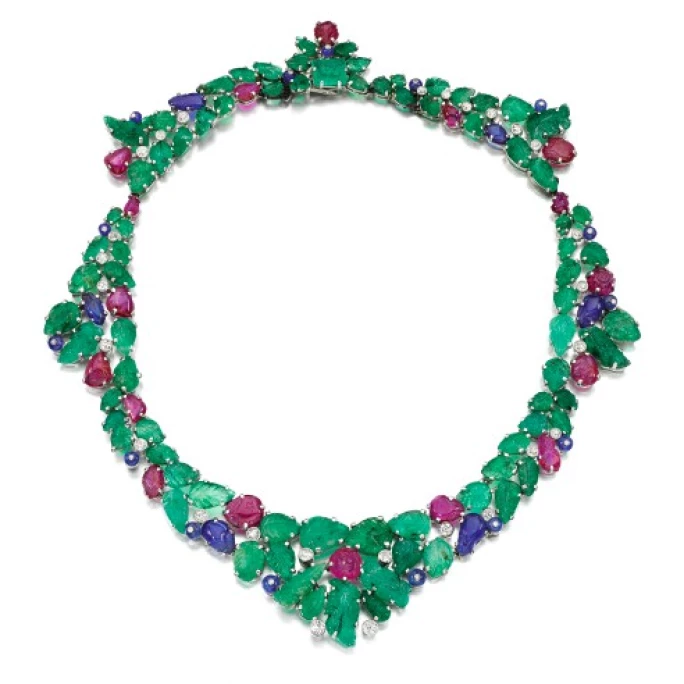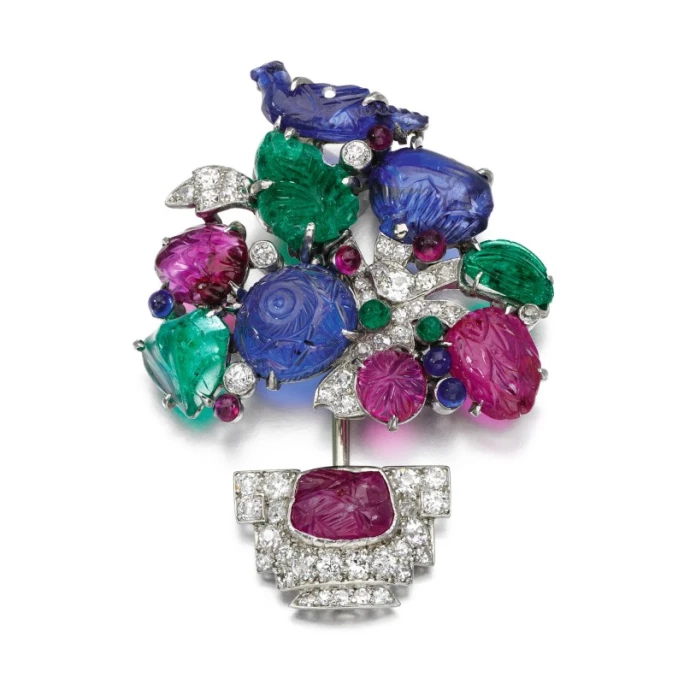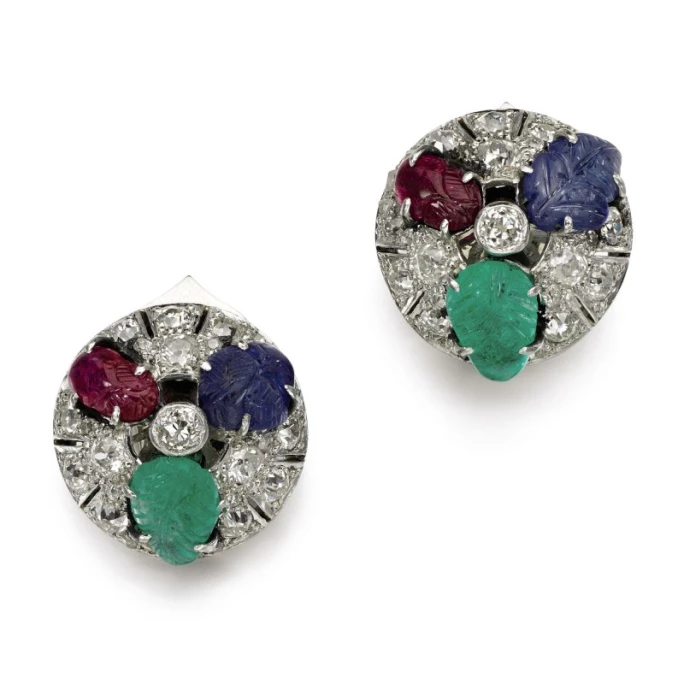Cartier's Tutti Frutti style: a marriage of East and West
- lucilledaver1
- Sep 30, 2024
- 5 min read
Updated: Jan 6

Cartier’s Tutti Frutti style, a hallmark of early 20th-century jewellery art, is a testament to vibrant South Asian designs. The style, known for its bold combinations of bright colours and Mughal-inspired motifs, was popularized by high society figures such as French socialite Daisy Fellowes. Cartier’s Tutti Frutti jewellery feature carved ruby, emeralds, and sapphires in leaf and flower shapes, and diamonds dancing supplely on an articulated platinum setting.

Design and gems for a new Tutti Frutti necklace by Cartier.
The emergence of a style
In 1901, Alexandra of Denmark, Queen consort of the United Kingdom, commissioned a piece from Pierre Cartier. She requested a single necklace to complement three outfits that Mary Curzon, Baroness Curzon of Kedleston, had brought her from India. The resultant necklace was reflective of traditional South Asian ornaments and vivid colours (emeralds, rubies, and sapphires). This jewel forged Cartier’s cultural link with India and was the first in a series of works influenced by the subcontinent’s gems and motifs.

Queen Alexandra, pictured here at the coronation of her husband Edward VII, wearing an Indian-inspired necklace commissioned from Cartier in 1901. W. and D. Downey
In 1911, Pierre’s brother Jacques, travelled to India to attend the coronation of King George V. This initial trip was pivotal for the House of Cartier, as it allowed him to meet several maharajahs and other affluent clients who later commissioned masterpieces from the company. He also discovered, through contact with Indian lapidaries, opulent jewellery featuring engraved and sculpted stones, stemming from Mughal jewellery-making traditions. Gems cut in novel ways in the shape of berries, leaves, and flowers, rubies and emeralds, captivated the Cartier brothers.

Jacques Cartier with merchants in India, 1911-1912, Photographic print from Jacques Cartier's travel album, Archives Cartier Paris
In the 1920s, after several trips to India, the Cartier brothers began to integrate these South Asian influences into their creations, setting carved rubies, emeralds and sapphires on platinum structures adorned with diamonds. A perfect marriage between the exuberance of Mughal designs and the streamlined look characteristic of art deco, these pieces stand out for their vivid colours and natural motifs— a departure from the more conventional, geometric designs and white diamond-heavy garlands and bows that dominated offerings at the time.
The house called this style “Hindu,” and then “leaf jewel.” In the 1970s, the style was renamed “Tutti Frutti” to emphasize how the carved gems resembled berries, leaves, and flowers.
One of the first pieces in this style was sold to a Linda Porter in 1925. It was a bracelet adorned with carved rubies, sapphires, and emeralds, set off by small diamonds and onyx beads. Porter fell in love with the style and bought another bracelet and a double-clip brooch in a similar design. These pieces became a sensation, and Cartier customers started lining up for similar items.

‘Tutti Frutti’ bracelet, 1925 Commissioned by Mrs. Cole Porter, platinum, diamonds, sapphires, rubies, emeralds, onyx, enamel, 19.5 x 3.8 cm Collection Cartier, Nils Herrmann Cartier
Various Tutti Frutti pieces dating from 1928 to 1950 adorned with rubies, emeralds, sapphires and diamonds. Sothebys
The creation of an iconic piece
One of the most significant and emblematic pieces of the Tutti Frutti style was commissioned by Daisy Fellowes, Paris editor of American Harper’s Bazaar. A famous socialite and heiress, Fellowes played a key role in popularizing the style. Inspired by a necklace made in 1925 for the Maharaja of Patna, Pierre Cartier set approximately 200 carved and bead emeralds, sapphires (including 13 briolette sapphires of approximately 145 carats), rubies, and 238 diamonds in a masterly necklace. He completed the piece in 1936 for Fellowes.
The necklace was a resounding triumph for its creativity and versatility—the perfect incarnation of the Tutti Frutti style. It was designed to be worn around the neck with a black satin cord or transformed into a brooch, so the central part of the necklace stood out (formed by two large cut sapphire buds, diamond-set emerald pearls, cut ruby leaves and diamonds).
The Tutti Frutti style was propelled into the global spotlight when Fellowes was featured wearing the necklace in Vogue. The magazine featured a double-page spread devoted to the “oriental splendour” and “barbaric” gem cuts of the style.

Portrait by Cecil Beaton, 1936, of the American heiress Daisy Fellowes wearing her ‘Hindu Necklace’. Cecil Beaton studio archives at Sotheby's
After her death, the necklace passed to her daughter, Emmeline de Castéja, who had Cartier modify it in 1962. The piece was fashioned into a fixed necklace, and the two large sapphires that had previously formed the central part of the necklace were integrated into the new clasp. Her transformation adapted the necklace to contemporary trends while preserving its original essence.
In 1991, five years after Emmeline’s death, the necklace was auctioned in Geneva. It was bought back by Cartier for US$2,655,172—setting the world auction record for a Cartier Tutti Frutti jewel.

Daisy Follows Hindu necklace created by Cartier in 1936. Sothebys
Tutti Frutti’s continuing influence
The popularity of the Tutti Frutti style continues unabated. To this day, Cartier's Tutti Frutti line remains one of the most sought-after - and therefore most expensive - in the history of jewellery and continues to be objects of desire among collectors and art lovers. The unique blend of colours and shapes inspired by Indian traditions, combined with the modernity of Art Deco design, gives these pieces lasting value and appeal. All to the delight of Sotheby's, which regularly orchestrates auctions of these precious jewels. These are exceptional pieces that can remain hidden for years, before resurfacing and shining brightly to the delight of lovers of precious stones and history. In 2014, a 1928 bracelet from the collections of Estée Lauder and Evelyn H. Lauder sold for US$2.1 million, setting a new world record; in 2017, another 1928 bracelet sold for US$1.8 million; and in 2020, another bracelet sold for US$1.34 million, setting a new record for an online jewellery sale. These sales testify to the continuing demand for these rare and precious pieces, which capture the opulence and glamour of the Jazz Age.

Cartier's Tutti Frutti bracelets Platinum, diamonds, sapphires, emeralds, rubies, sold by Sothebys in (1) 2014 from the collection of Evelyn H. Lauder, circa 1928; (2) 2017 circa 1928 and (3) 2020 circa 1928
Conclusion
Tutti Frutti's important pieces are the rarest and most sought-after works of art in the world of jewellery. They have been collected by such patrons as Queen Mary and Mrs William K. Vanderbilt, among others. In 2016, Cartier relaunched the Tutti Frutti collection producing exquisite pieces that can take thousands of hours to create by delving into its heritage jewellery, including a number of fantastic examples from the 1920s and 1930s. Cartier's Tutti Frutti style is a perfect example of how cultural influence can transform craftsmanship and create works of timeless beauty. Inspired by Jacques Cartier's travels in India and popularised by icons such as Daisy Fellowes, the style illustrates the blending of Eastern and Western traditions. Tutti Frutti creations are not just jewellery, but also testimonies to a cultural exchange that has enriched the history of jewellery.

Jewellery from the Tutti Frutti collection by Cartier.
References
Bauwens, M., 2022. Le « Tutti Frutti » : un cocktail moderne de l’Inde moghole, Beaux art, février 2022, <https://www.beauxarts.com/grand-format/le-tutti-frutti-un-cocktail-moderne-de-linde-moghole/>.
Cartier Brickell F., 2020, The Story of Cartier Tutti Frutti Jewels, As Told by a Descendant , Apr, 2020. Sothebys. <https://www.sothebys.com/en/articles/the-story-of-tutti-frutti-jewels-as-told-by-a-cartier-descendant>.
Menkes, S. (2013). Reign of Cartier, jeweler to royalty; Grand Palais exhibition captures the vision and expertise of luxury house. International New York Times, NA-NA.
Raden, A. (2016). GEM: The definitive visual guide. Penguin.
Brickell, F. C. (2019). The Cartiers: The untold story of the family behind the jewelry empire. Ballantine Books.
Volandes, S., 2020, The Story of the Cartier Tutti Frutti Is a Marriage of French Design and Indian Royalty, Town&country, April 2020, <https://www.townandcountrymag.com/style/jewelry-and-watches/a32252985/cartier-tutti-frutti-design-history/>.










コメント